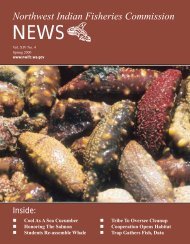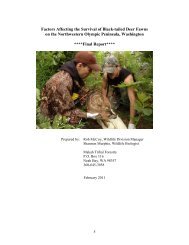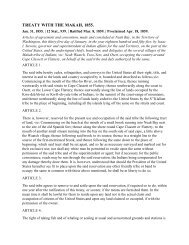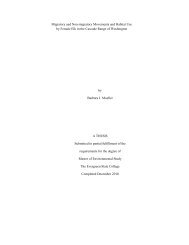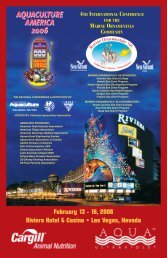Draft TRT Document â for Discussion Purposes ... - NWIFC Access
Draft TRT Document â for Discussion Purposes ... - NWIFC Access
Draft TRT Document â for Discussion Purposes ... - NWIFC Access
Create successful ePaper yourself
Turn your PDF publications into a flip-book with our unique Google optimized e-Paper software.
<strong>Draft</strong> <strong>TRT</strong> <strong>Document</strong> – <strong>for</strong> <strong>Discussion</strong> <strong>Purposes</strong> – OK to circulateHood Canal, East Side TributariesThere is little in<strong>for</strong>mation on steelhead abundance in creeks draining from the eastside of Hood Canal. In 1920, an egg collecting station was established on the TahuyaRiver to intercept returning steelhead. In May and June of 1932, the WashingtonDepartment of Fisheries surveyed streams throughout the Hood Canal. Of the 26 surveysavailable <strong>for</strong> review, all of the larger streams and many smaller creeks were reported tohave spawning steelhead from January through March (WDF 1932). Mission Creek andDewatto Creek [sic] were identified as having “good” runs and the Tahuyeh River [sic]contained a small to medium run. Anderson Creek, Union River, Big Beef Creek wereall reported to contain small spawning populations of steelhead. Smaller stream systems,<strong>for</strong> example Stavis and Rendsland creeks, all supported steelhead spawning, albeit at alow abundance in the 1930s. Additionally, both sea-run and resident cutthroat wereobserved throughout Hood Canal.Hood Canal, West Side TributariesRecords <strong>for</strong> these west-side tributaries to Hood Canal are somewhat limited. Atvarying times during the early 1900s the Bureau of Fisheries operated egg collectionstations or hatcheries on Quilcene, Dosewallips, and Duckabush rivers. Although theprimary objective of these operations was the collection of coho and chum salmon eggsthere were a number of steelhead eggs collected, especially from the Duckabush Riverand Quilcene rivers. It was noted that the greater part of the steelhead run ascended byspring high water when the trap could not be operated, many of the fish collected were“too immature to be retained in ponds” (Leach 1927). Ripe fish were spawned fromMarch 24 th to May 1 st in 1926.In the 1932 Washington Department of Fisheries survey the Dosewallips Riverwas specifically mentioned as containing a “large run” of steelhead and the HammaHamma was reported to have a small to medium run of saltwater steelhead and cutthroats(WDF 1932). Of the remaining creeks surveyed: Mission Creek, Little Mission, Dabob,Lilliwaup, Waketickeh, Jorsted, Spencer, Jackson, Finch, and Eagle Creeks were allreported to have small spawning populations of steelhead. It was observed that thesteelhead run began in January and February, and only a small portion of the steelheadrun entered the Little Quilcene River be<strong>for</strong>e the hatchery weir was put in place in March.Steelhead were reported spawning during the late winter and early spring. Notablyabsent were surveys <strong>for</strong> the Skokomish and Duckabush Rivers. Punch card records fromthe late 1940s to 1960s report catches of tens to hundreds of fish from several west-sideHood Canal basins.Dungeness RiverIn the 1940s, Clarence Pautzke with the Washington Department of Fisheries(undated) described the winter steelhead fishing in the Dungeness River as being amongthe best in the State. In 1903, during its second year of operation, the DungenessHatchery produced 3,100,840 steelhead. This production represents approximately 2,20034



